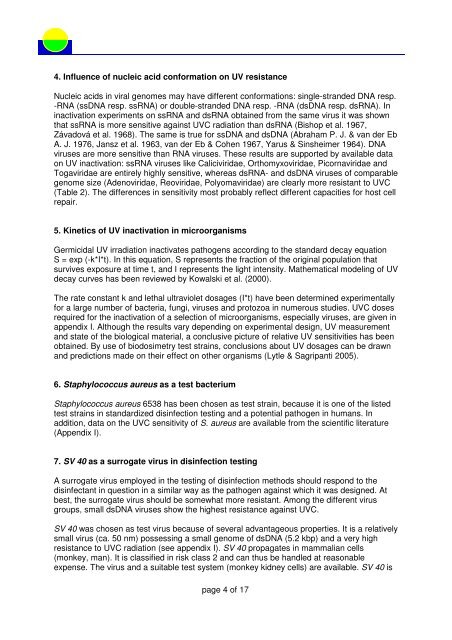CERTIFICATE Inactivation of bacteria, viruses and other pathogens ...
CERTIFICATE Inactivation of bacteria, viruses and other pathogens ...
CERTIFICATE Inactivation of bacteria, viruses and other pathogens ...
You also want an ePaper? Increase the reach of your titles
YUMPU automatically turns print PDFs into web optimized ePapers that Google loves.
4. Influence <strong>of</strong> nucleic acid conformation on UV resistance<br />
Nucleic acids in viral genomes may have different conformations: single-str<strong>and</strong>ed DNA resp.<br />
-RNA (ssDNA resp. ssRNA) or double-str<strong>and</strong>ed DNA resp. -RNA (dsDNA resp. dsRNA). In<br />
inactivation experiments on ssRNA <strong>and</strong> dsRNA obtained from the same virus it was shown<br />
that ssRNA is more sensitive against UVC radiation than dsRNA (Bishop et al. 1967,<br />
Závadová et al. 1968). The same is true for ssDNA <strong>and</strong> dsDNA (Abraham P. J. & van der Eb<br />
A. J. 1976, Jansz et al. 1963, van der Eb & Cohen 1967, Yarus & Sinsheimer 1964). DNA<br />
<strong>viruses</strong> are more sensitive than RNA <strong>viruses</strong>. These results are supported by available data<br />
on UV inactivation: ssRNA <strong>viruses</strong> like Caliciviridae, Orthomyxoviridae, Picornaviridae <strong>and</strong><br />
Togaviridae are entirely highly sensitive, whereas dsRNA- <strong>and</strong> dsDNA <strong>viruses</strong> <strong>of</strong> comparable<br />
genome size (Adenoviridae, Reoviridae, Polyomaviridae) are clearly more resistant to UVC<br />
(Table 2). The differences in sensitivity most probably reflect different capacities for host cell<br />
repair.<br />
5. Kinetics <strong>of</strong> UV inactivation in microorganisms<br />
Germicidal UV irradiation inactivates <strong>pathogens</strong> according to the st<strong>and</strong>ard decay equation<br />
S = exp (-k*I*t). In this equation, S represents the fraction <strong>of</strong> the original population that<br />
survives exposure at time t, <strong>and</strong> I represents the light intensity. Mathematical modeling <strong>of</strong> UV<br />
decay curves has been reviewed by Kowalski et al. (2000).<br />
The rate constant k <strong>and</strong> lethal ultraviolet dosages (I*t) have been determined experimentally<br />
for a large number <strong>of</strong> <strong>bacteria</strong>, fungi, <strong>viruses</strong> <strong>and</strong> protozoa in numerous studies. UVC doses<br />
required for the inactivation <strong>of</strong> a selection <strong>of</strong> microorganisms, especially <strong>viruses</strong>, are given in<br />
appendix I. Although the results vary depending on experimental design, UV measurement<br />
<strong>and</strong> state <strong>of</strong> the biological material, a conclusive picture <strong>of</strong> relative UV sensitivities has been<br />
obtained. By use <strong>of</strong> biodosimetry test strains, conclusions about UV dosages can be drawn<br />
<strong>and</strong> predictions made on their effect on <strong>other</strong> organisms (Lytle & Sagripanti 2005).<br />
6. Staphylococcus aureus as a test bacterium<br />
Staphylococcus aureus 6538 has been chosen as test strain, because it is one <strong>of</strong> the listed<br />
test strains in st<strong>and</strong>ardized disinfection testing <strong>and</strong> a potential pathogen in humans. In<br />
addition, data on the UVC sensitivity <strong>of</strong> S. aureus are available from the scientific literature<br />
(Appendix I).<br />
7. SV 40 as a surrogate virus in disinfection testing<br />
A surrogate virus employed in the testing <strong>of</strong> disinfection methods should respond to the<br />
disinfectant in question in a similar way as the pathogen against which it was designed. At<br />
best, the surrogate virus should be somewhat more resistant. Among the different virus<br />
groups, small dsDNA <strong>viruses</strong> show the highest resistance against UVC.<br />
SV 40 was chosen as test virus because <strong>of</strong> several advantageous properties. It is a relatively<br />
small virus (ca. 50 nm) possessing a small genome <strong>of</strong> dsDNA (5.2 kbp) <strong>and</strong> a very high<br />
resistance to UVC radiation (see appendix I). SV 40 propagates in mammalian cells<br />
(monkey, man). It is classified in risk class 2 <strong>and</strong> can thus be h<strong>and</strong>led at reasonable<br />
expense. The virus <strong>and</strong> a suitable test system (monkey kidney cells) are available. SV 40 is<br />
page 4 <strong>of</strong> 17


